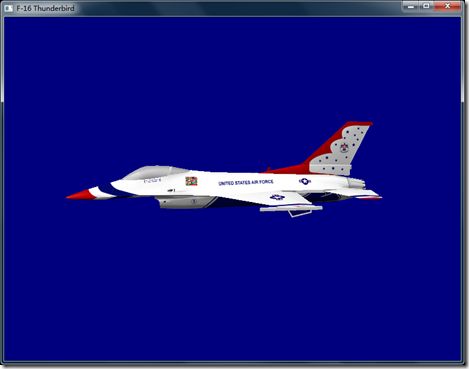OpenGL超级宝典笔记——性能比较
本文通过包含许多顶点数据的复杂模型来比较使用glBegin()/glEnd立即模式,显示列表,以及顶点索引数组的性能与内存。
F-16 Thunderbird的飞机模型有3704个独立的三角形,通过Deep Exporation工具的索引模式编制后,共有1898个独立的顶点,2716个法线,2925个纹理坐标。
下面代码展示DrawBody函数,通过遍历索引来为每一个独立的三角形设置并发送纹理,法线和顶点坐标。
void DrawBody(void){
int iFace, iPoint; glBegin(GL_TRIANGLES); for(iFace = 0; iFace < 3074; iFace++) //遍历每一个三角形 for(iPoint = 0; iPoint < 3; iPoint++) //每一个顶点 { //设置纹理 glTexCoord2fv(textures[face_indices[iFace][iPoint+6]]); //设置法线 glNormal3fv(normals[face_indices[iFace][iPoint+3]]); //设置顶点 glVertex3fv(vertices[face_indices[iFace][iPoint]]); } glEnd();}
当你必须优化模型的存储空间时,这种方法是可以的。例如你在嵌入式中需要节省内存,或者在网络上传输时需要减少流量。但在实时应用中,这种方法的性能非常差,因为每一次都向OpenGL发送一个顶点数据,函数调用的次数也特别多。
显而易见的加速这些代码执行的速度就是使用显示列表的方式。我们把这些代码放到显示列表中。
glNewList(bodyList, GL_COMPILE);
DrawBody();
glEndList();
….
glCallList(bodyList);
下面我们来对比一下显示列表的方式和顶点索引数组的方式。
计算花费
首先计算一下这些经过包装过的顶点数据的所需要的内存。
// Thunderbird bodyextern short face_indicies[3704][9];
extern GLfloat vertices [1898][3];
extern GLfloat normals [2716][3];
extern GLfloat textures [2925][2];
其中face_indicies包含了顶点,法线,和纹理的索引 short face_indicies[3704][9] = {{6,8,7 ,0,1,2 ,0,1,2 }, {6,9,8 ,0,3,1 ,0,3,1 }, {10,8,11 ,4,1,5 ,4,1,5 }....}
face_indicies 需要 3074*9*sizeof(short), 55332字节.类似地计算出vertices要22776字节,normals 32592字节。textures 23400字节。总计134100 约130KB.
在显示列表中,我们需要把这些数据拷贝一份到显示列表(显示列表中的命令和数据会经过优化后,放到命令缓冲区或者图形硬件中)我们没法计算显示列表具体使用多少内存,但可以对顶点的数据进行估算。每个三角形需要3个顶点,3个法线,2个纹理坐标,这些都是浮点数。假设sizeof(float)为4个字节。那么:
3704*3=11112个顶点。每个顶点包含3个成分(x,y,z)所以有11112*3=33336个浮点数值,同理法线有33336个浮点值,纹理坐标有22224个浮点值。把这些加起来再乘以4个字节为335,584个字节。那么加上之前的原始数据有469684个字节 约460kb,不到0.5M.但是我们有11,112个顶点数据需要经过OpenGL的变换管道,这里面包含了许多矩阵运算。
创建合理的顶点索引数组
上面所存储的数据还不能直接用于OpenGL的顶点数组。因为OpenGL要求顶点数组,法线数组和纹理坐标数组必须是同样的大小,这样数组的遍历方式才能保持一致。顶点数组的第0个元素和法线数组的第0个元素是对应的。对于索引数组也有同样的要求。
在下面的例子中,我们使用一个类来处理现有的数组,并为其建立索引。下面是处理机身和玻璃座舱盖并建立索引的代码:
CTriangleMesh thunderBirdBody;CTriangleMesh thunderBirdGalss;
//临时空间
M3DVector3f vVerts[3];
M3DVector3f vNorms[3];
M3DVector2f vTex[3];//开始收集机身的网格,设置最大值
thunderBirdBody.BeginMesh(3074*3);//循环所有面
for(int iFace = 0; iFace < 3074; iFace++)
{for(int iPoint = 0; iPoint < 3; iPoint++) { memcpy(&vVerts[iPoint][0], &vertices[face_indices[iFace][iPoint][0]], sizeof(M3DVector3f)); memcpy(&vNorms[iPoint][0], &normals[face_indices[iFace][iPoint+3][0]], sizeof(M3DVector3f)); memcpy(&vTex[iPoint][0], &textures[face_indices[iFace][iPoint+6][0]], sizeof(M2DVector2f)); } thunderBirdBody.AddTriangle(vVerts, vNorms, vTex);}
//结束,并缩放顶点的值,以便屏幕的显示。
thunderBirdBody.EndMesh();
thunderBirdBody.Scale(fScale);thunderBirdGlass.BeginMesh(352*3);
for(int iFace = 0; iFace < 352; iFace++)
{for(int iPoint = 0; iPoint < 3; iPoint++) { memcpy(&vVerts[iPoint][0], &verticesGlass[face_indiciesGlass[iFace][iPoint]][0], sizeof(M3DVector3f)); memcpy(&vNorms[iPoint][0], &normalsGlass[face_indiciesGlass[iFace][iPoint+3]][0], sizeof(M3DVector3f)); memcpy(&vTex[iPoint][0], &texturesGlass[face_indiciesGlass[iFace][iPoint+6]][0], sizeof(M3DVector2f)); }thunderBirdGlass.AddTriangle(vVerts, vNorms, vTex);
}thunderBirdGlass.EndMesh();
thunderBirdGlass.Scale(fScale);
首先,我们声明了两个三角形网格类
CTriangleMesh thunderBirdBody;
CTriangleMesh thunderBirdGalss;
然后我们要告诉包含所有顶点所需要的大小的最大值,在最坏的情况下我们可能有3074个唯一的顶点,但一般情况下,许多顶点是共享的,值是一样的。
thunderBirdBody.BeginMesh(3074*3);
然后遍历集体所有的面,并收集每一个独立的三角形,并作为AddTriangle的参数,AddTriagnle会组织索引数组。在AddTriangle函数中把传进来的参数与之前的顶点数据进行比较看是否有重复的。如果是重复的在索引数组中就用同一个索引值。其内部处理代码:
for(GLuint iVertex = 0; iVertex < 3; iVertex++)
{ GLuint iMatch = 0; for(iMatch = 0; iMatch < nNumVerts; iMatch++) { // If the vertex positions are the same if(m3dCloseEnough(pVerts[iMatch][0], verts[iVertex][0], e) && m3dCloseEnough(pVerts[iMatch][1], verts[iVertex][1], e) && m3dCloseEnough(pVerts[iMatch][2], verts[iVertex][2], e) && // AND the Normal is the same... m3dCloseEnough(pNorms[iMatch][0], vNorms[iVertex][0], e) && m3dCloseEnough(pNorms[iMatch][1], vNorms[iVertex][1], e) && m3dCloseEnough(pNorms[iMatch][2], vNorms[iVertex][2], e) && // And Texture is the same... m3dCloseEnough(pTexCoords[iMatch][0], vTexCoords[iVertex][0], e) && m3dCloseEnough(pTexCoords[iMatch][1], vTexCoords[iVertex][1], e)) { // Then add the index only pIndexes[nNumIndexes] = iMatch; nNumIndexes++; break; } } // No match for this vertex, add to end of list if(iMatch == nNumVerts) { memcpy(pVerts[nNumVerts], verts[iVertex], sizeof(M3DVector3f)); memcpy(pNorms[nNumVerts], vNorms[iVertex], sizeof(M3DVector3f)); memcpy(pTexCoords[nNumVerts], &vTexCoords[iVertex], sizeof(M3DVector2f)); pIndexes[nNumIndexes] = nNumVerts; nNumIndexes++; nNumVerts++; } }
比较开销
现在让我们来比较这三种渲染模型的方式的开销。在CTriangleMesh类的统计中,Thunderbird的机身模型中共有3265个唯一的顶点(包含法线和纹理坐标)和11,112个索引。每个顶点和法线包含3个浮点值,纹理坐标包含两个浮点值。所以
3265*8=26120个浮点值。再乘以4有104,480字节,再加上使用short类型创建的索引数组11,112*2=22,224字节。 总共有126,704个字节,约124kb
对比表格:
| 渲染模式 | 内存使用量 | 需要变换的顶点格式 |
| 立即模式 | 约130kb | 11,112 |
| 显示列表 | 约460kb | 11,112 |
| 顶点索引数组 | 约124kb | 3,265 |
从上面的表格可以看出,顶点索引数组不但使用了更少的内存,而且仅仅需要处理其他模式三分之一的顶点。如果模型有许多尖锐的角或边那么共享的顶点数就较少,如果模型是平滑的表面那么共享的顶点数就多。使用顶点索引数组的方式能够极大的提升性能。
源代码:https://github.com/sweetdark/openglex/tree/master/thunderbird
